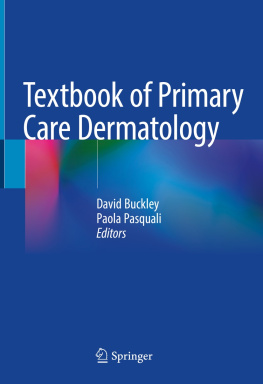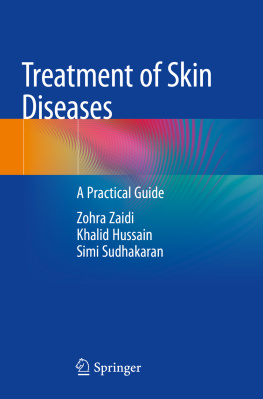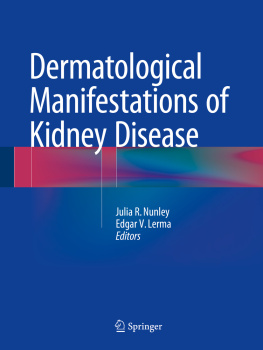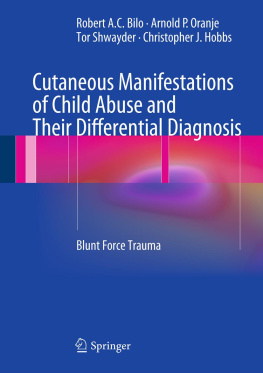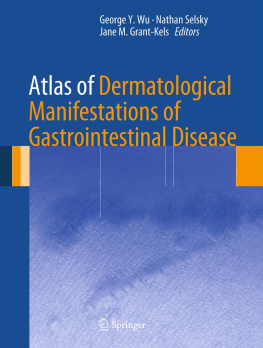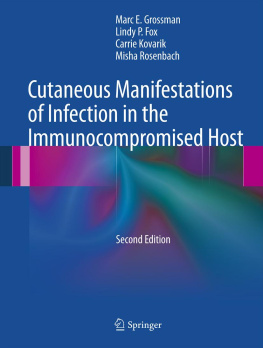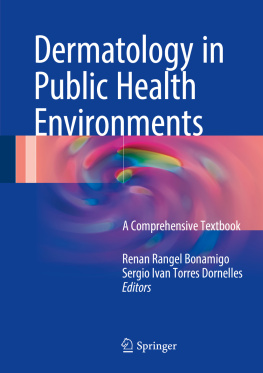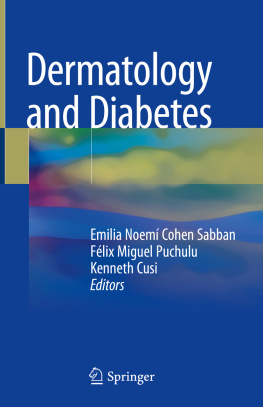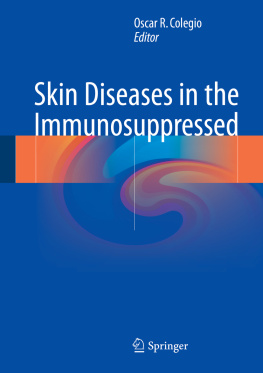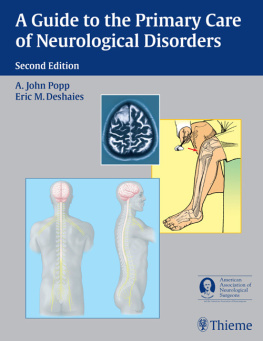Editors
Julian Trevino and Amy Y-Y Chen
Dermatological Manual of Outdoor Hazards
Editors
Julian Trevino
Boonshoft School of Medicine, Wright State University, Dayton, OH, USA
Amy Y-Y Chen
Central Connecticut Dermatology, Cromwell, CT, USA
ISBN 978-3-030-37781-6 e-ISBN 978-3-030-37782-3
https://doi.org/10.1007/978-3-030-37782-3
Springer Nature Switzerland AG 2020
This work is subject to copyright. All rights are reserved by the Publisher, whether the whole or part of the material is concerned, specifically the rights of translation, reprinting, reuse of illustrations, recitation, broadcasting, reproduction on microfilms or in any other physical way, and transmission or information storage and retrieval, electronic adaptation, computer software, or by similar or dissimilar methodology now known or hereafter developed.
The use of general descriptive names, registered names, trademarks, service marks, etc. in this publication does not imply, even in the absence of a specific statement, that such names are exempt from the relevant protective laws and regulations and therefore free for general use.
The publisher, the authors and the editors are safe to assume that the advice and information in this book are believed to be true and accurate at the date of publication. Neither the publisher nor the authors or the editors give a warranty, expressed or implied, with respect to the material contained herein or for any errors or omissions that may have been made. The publisher remains neutral with regard to jurisdictional claims in published maps and institutional affiliations.
This Springer imprint is published by the registered company Springer Nature Switzerland AG
The registered company address is: Gewerbestrasse 11, 6330 Cham, Switzerland
Preface
Hazardous exposures to arthropods and plants involve millions of patients annually and are becoming more frequent due to an ever-expanding array of outdoor occupational and recreational activities and increased domestic and international travel. Such exposures can result in skin conditions and systemic manifestations which range from minor annoyances to life-threatening illnesses. Arthropod vectors transmit diseases affecting millions and resulting in significant public health issues worldwide. Exposures to plants can affect exposed populations and result in significant morbidity (and rarely mortality), necessitating alteration in occupational/recreational activities or requiring limitations in dietary consumption of implicated plants. Media reports of exaggerated information on the adverse effects of plant and arthropod exposures abound. Physicians and healthcare providers in a variety of practice settings are in a unique position to provide accurate information about such exposures as well as to diagnose and manage adverse reactions to plants and arthropods. It is hoped that this manual will be utilized as a trusted reference for those seeking information on accurately diagnosing and managing such hazardous plant and arthropod exposures.
This manual provides an organized approach to recognition, diagnosis, and management of hazardous exposure to plants and arthropods. Following a review of skin lesion morphology and terminology, the subsequent chapters review the broad range of skin manifestations due to plant exposures based on the underlying pathogenic mechanism (plant-induced urticaria, irritant plant dermatitis, allergic contact dermatitis, phytophotodermatitis). The full spectrum of plant-induced dermatitis, emphasizing routes of exposure, plant identification, and clues to arriving at a diagnosis and providing effective management and preventative strategies, is presented. The remainder of the manual reviews the broad array of skin manifestations and related systemic findings due to exposure to a wide variety of arthropods. Due to their individual bites/stings and their role as vectors of disease worldwide, arthropod injuries to the skin and the systemic diseases resulting from some arthropod exposures can present significant diagnostic and therapeutic challenges to clinicians. The chapters on arthropod exposures will provide guidance to healthcare professional in the diagnosis, management, and prevention of such exposures.
Throughout the manual, emphasis is placed on obtaining pertinent historical information (e.g., exposure through occupational or recreational activities, pet/animal exposure, clothing worn, fragrances used, travel history), recognition of characteristic clinical findings, and appropriate patient evaluation and management. Preventative measures (use of repellants, protective clothing, barrier creams) and patient education are also emphasized as relate to the various exposures. While clinical manifestations of the various exposures can range from non-specific to highly characteristic, the manual provides a framework for healthcare professionals to comprehensively assess suspected plant and arthropod exposures and ultimately arrive at an accurate diagnosis.
Depending on practice location, physicians and providers may see some of these conditions infrequently and thus a review and update on this information is essential. With increasing mobility of populations and the ease of worldwide travel, a condition normally seen thousands of miles away can now suddenly present to a practitioner anywhere on the planet for evaluation. Physicians/providers should be familiar with potentially serious medical consequences and infectious conditions/complications related to cutaneous reactions resulting from specific plants and arthropods in order to deliver a rapid diagnosis, effective treatment, and comprehensive education to patients regarding safe and effective measures for management and prevention of hazardous plant and arthropod exposures. This manual will serve as a trusted resource to clinicians seeking to deliver outstanding care to such patients.
Julian Trevino
Amy Y-Y Chen
Dayton, USA Cromwell, USA
Acknowledgements
This manual represents the efforts of a team of gifted individuals. Sincere thanks to all of the contributing authors for their wisdom and dedication to the project. I am also indebted to my Co-Editor, Dr. Amy Y-Y Chen and all of my work colleagues, particularly the dermatology residents (especially Drs. Clay Conner and Elizabeth Usedom) whose support and assistance were essential to bringing this project to fruition. I am eternally grateful for the unending encouragement and inspiration provided by my family (Justin, Sarah and James Trevino and my beloved late parents, Joseph and Felicia Trevino), my church family at Westminster Presbyterian Church in Piqua, Ohio and many dear friends.
Contents
Hannah R. Badon , Andrew S. Desrosiers , Robert T. Brodell and Stephen E. Helms
Preeti Jhorar and Wyatt J. Andrasik
Reid A. Waldman and Jane M. Grant-Kels
Daniel A. Nguyen , Muneeza K. Muhammad and Grace L. Lee
Gillian Weston and Amy Y-Y Chen
Paul A. Regan , Galen T. Foulke and Elizabeth J. Usedom
David B. Duff , Andrew S. Desrosiers , Robert T. Brodell and Stephen E. Helms
Maia K. Erickson and Elizabeth M. Damstetter
Gloria Lin , Madeline DeWane and Diane Whitaker-Worth


